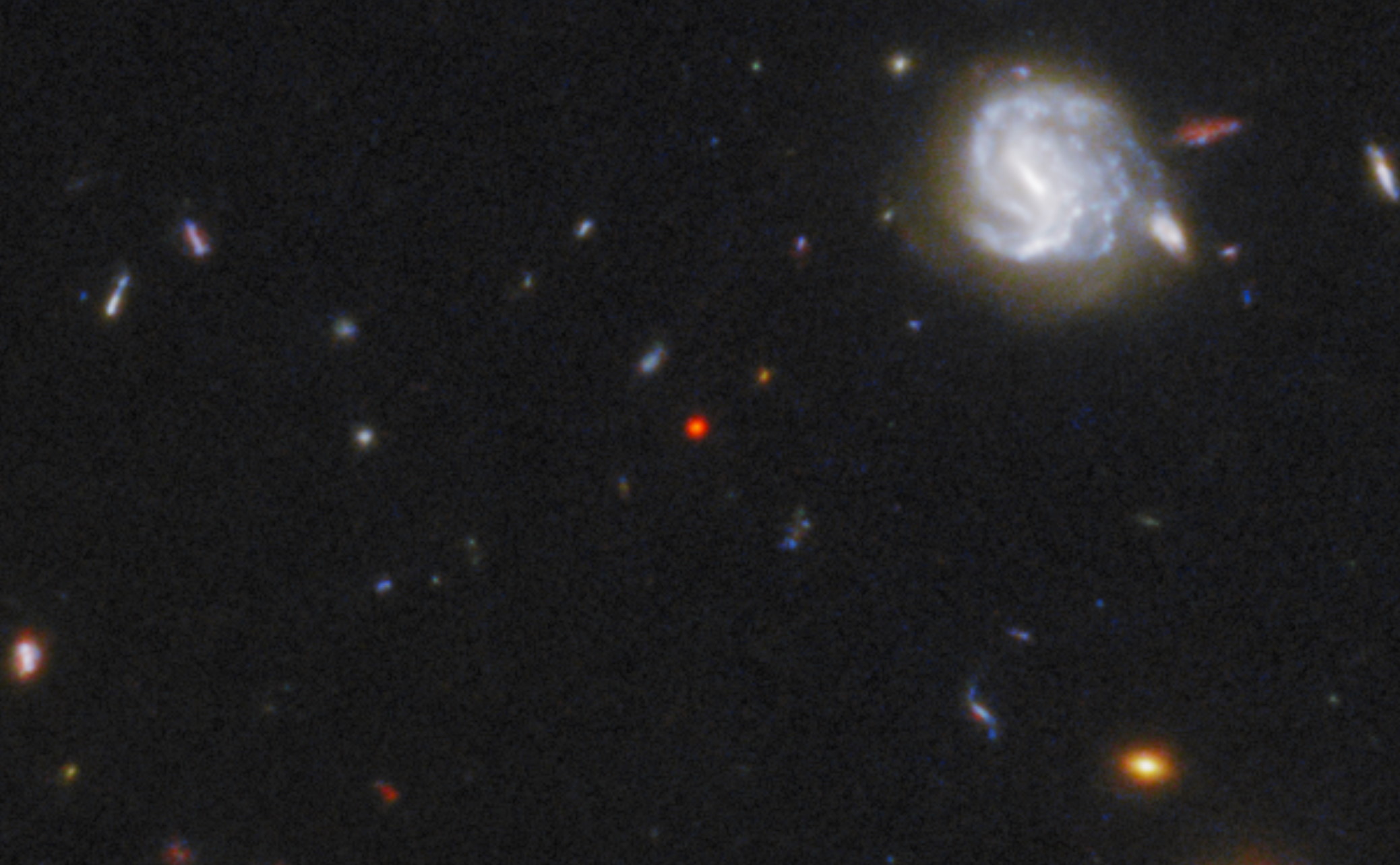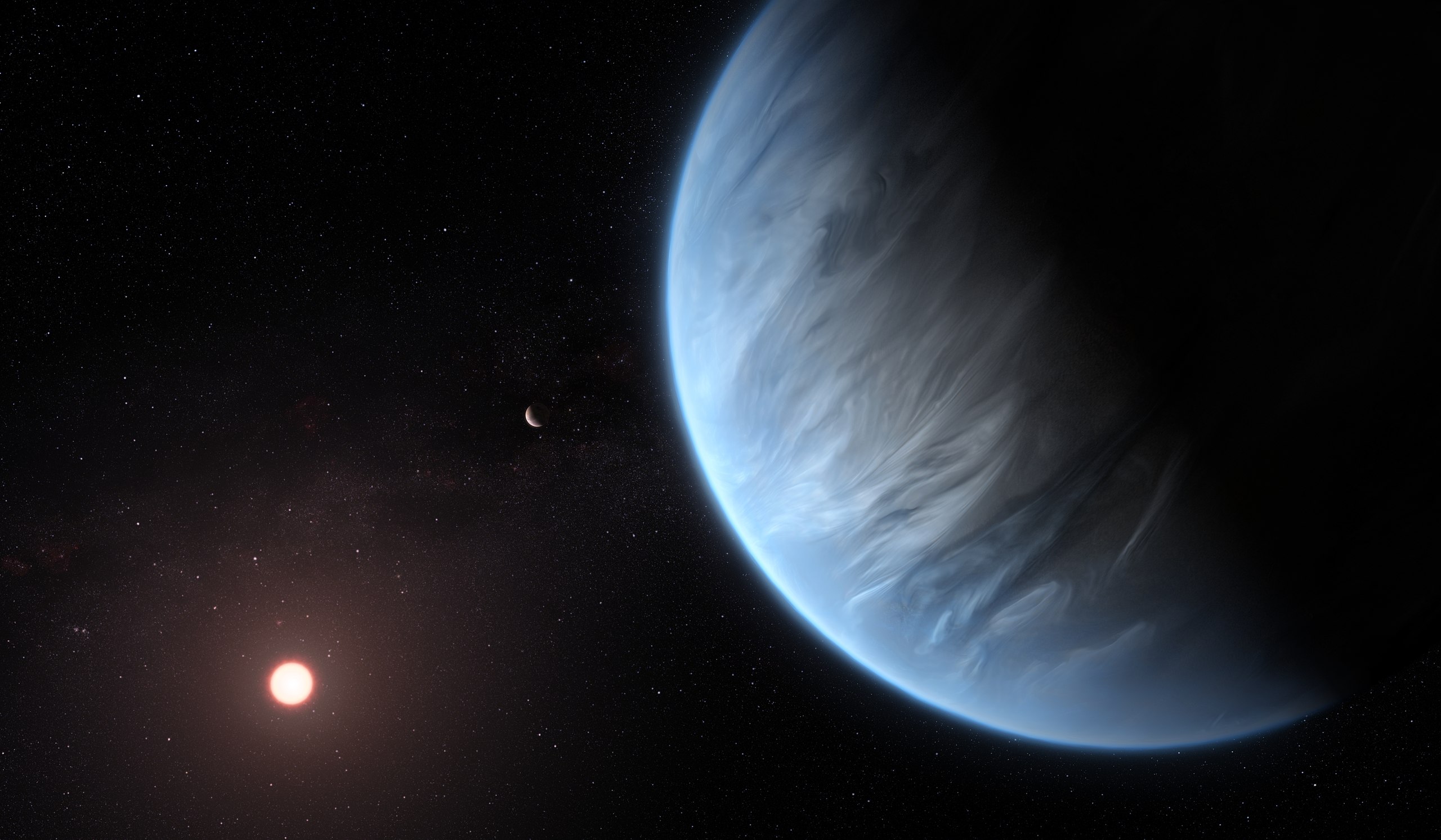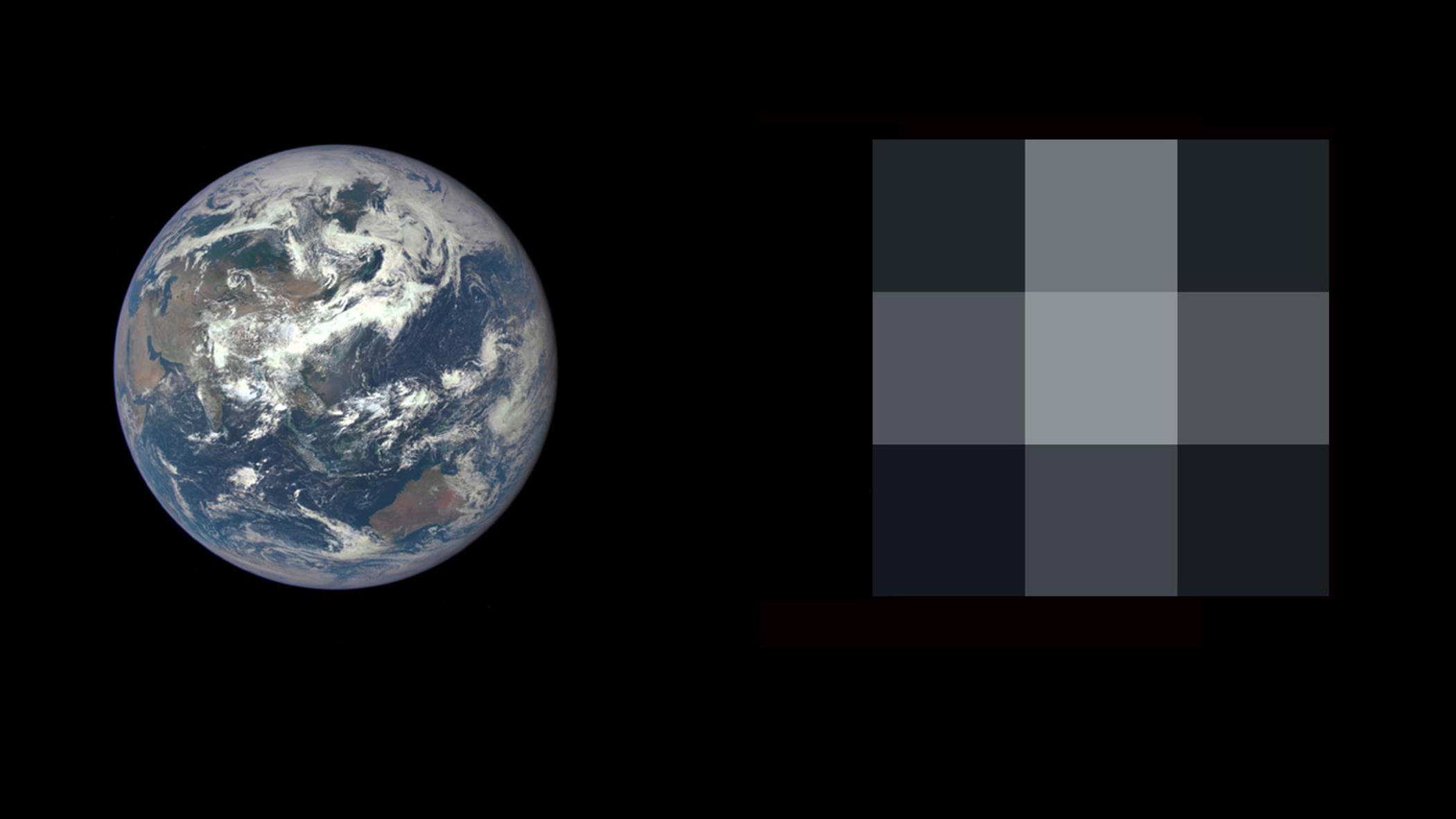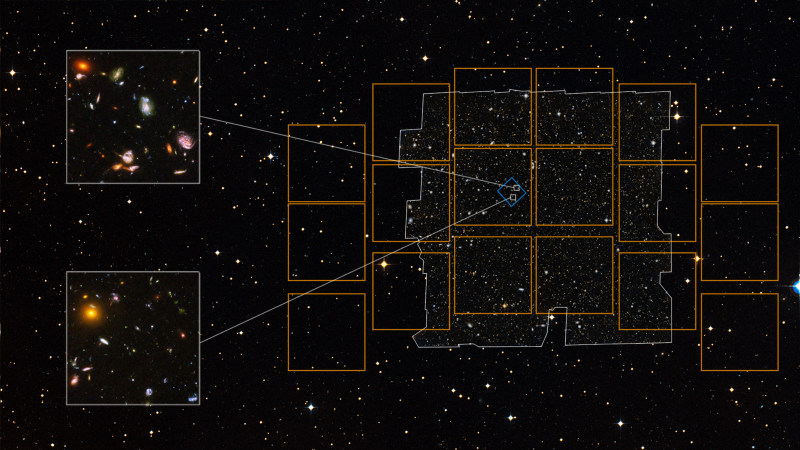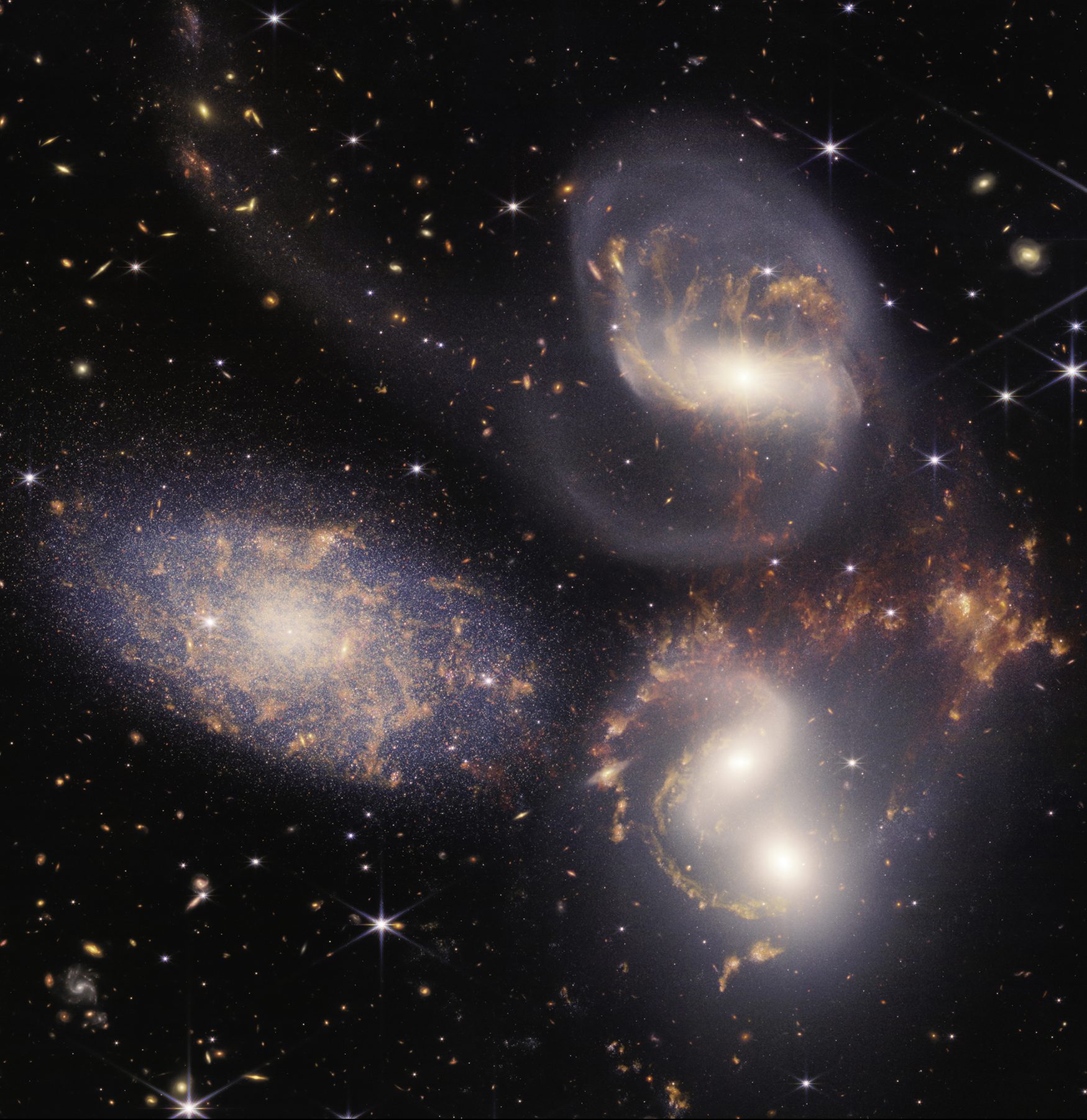Euclid’s first science images reveal what JWST cannot
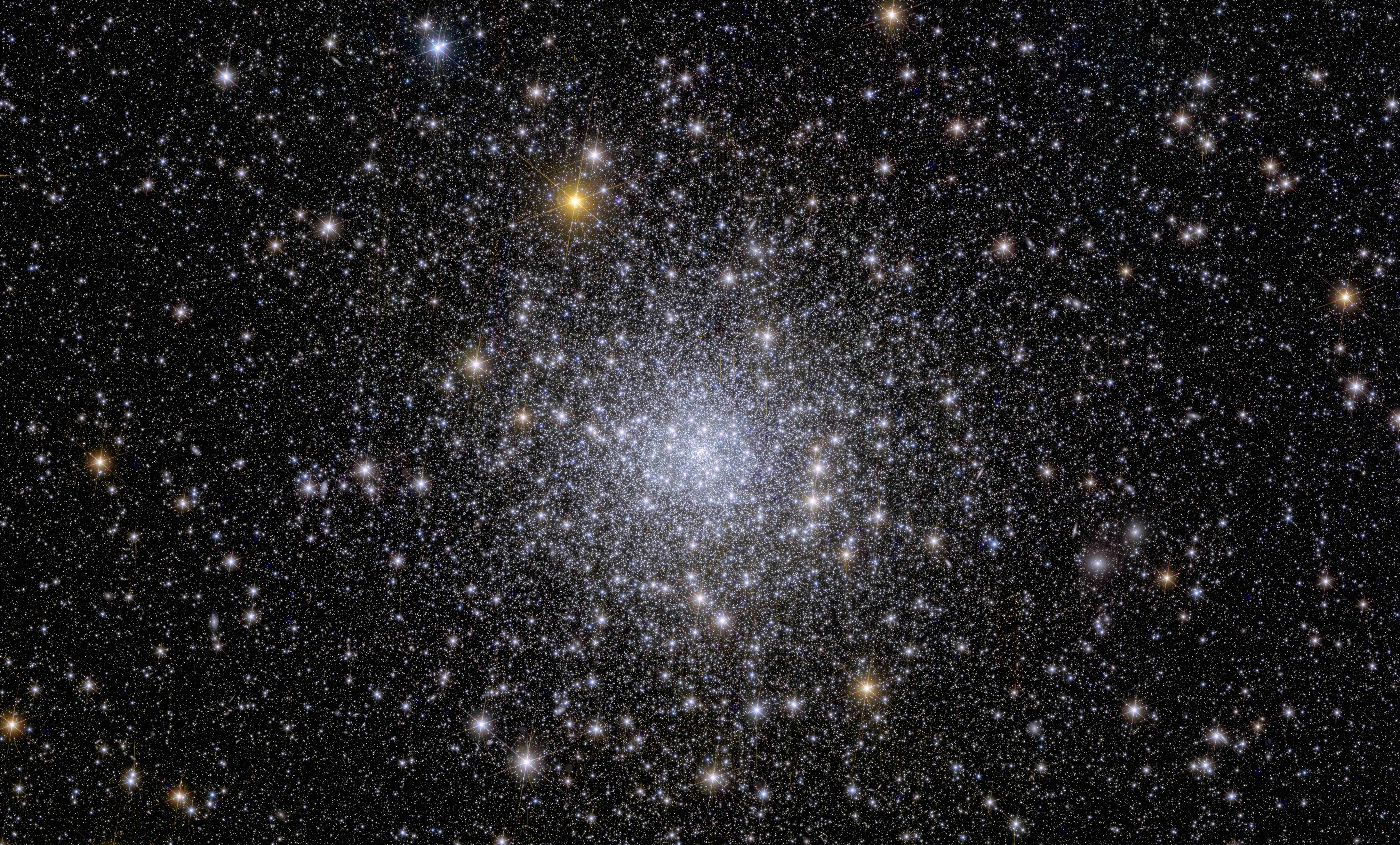
- ESA’s Euclid spacecraft. after four months of commissioning, calibration, and testing, has begun science operations as of early November, 2023. Its first science images have just been released.
- Unlike JWST, which was optimized for deep views across a wide variety of infrared wavelengths, Euclid’s wavelength range and light-gathering power is much smaller.
- However, Euclid is a wide-field imaging telescope, designed for large-area views of the nearby and intermediate-distance Universe, and will teach us about the 3D structure of the cosmic web. It’s already begun.
No single observatory, no matter how powerful, can ever teach us all we want to know about the Universe on its own. No matter how advanced our telescope technology gets, there will always be a tradeoff between:
- size and cost,
- wavelength coverage and observing time required,
- and resolution and field-of-view,
among other aspects. While telescopes like Hubble and JWST have captured our imaginations with their deep, high-resolution views all across the Universe, they also face a tremendous limitation: they have narrow, small-angle fields of view, and can only see a tiny fraction of the sky at once.
But other observatories — although they’re usually smaller, lower in resolution, and cover narrower sets of wavelength ranges — have the advantage of being able to image large areas of the sky all at once. While NASA’s upcoming Nancy Grace Roman Space Telescope and the NSF’s Vera Rubin observatory will excel in those regards, the ESA’s Euclid mission has gotten there first: having launched in July of 2023 and now, in November, begins its 6+ year mission to map out as much of the Universe as possible. It’s a remarkable and ambitious project, and not only are its science operations already underway, but it’s going to revolutionize what we know about the Universe. Here’s how.
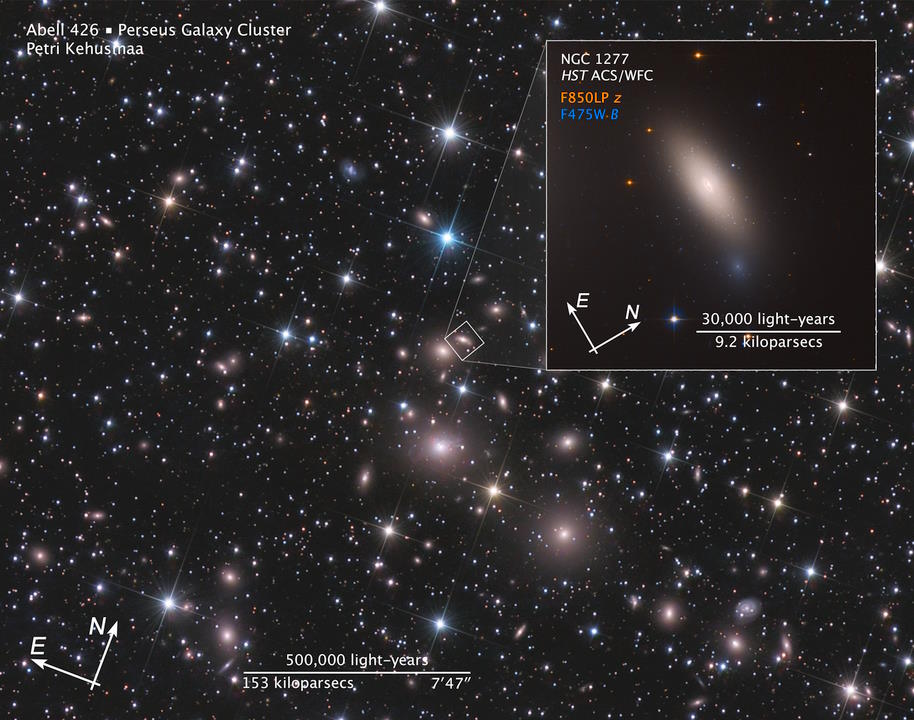
What you see, above, represents one of humanity’s best-ever images of the Perseus galaxy cluster as of mid-2023: prior to the launch of ESA’s Euclid. While the tiny inset image of the unusual galaxy NGC 1277 represents two cycles of Hubble data — one ~45 minute (half of a HST orbit around the Earth: the portion where Earth isn’t blocking the spacecraft’s view) exposure at blue wavelengths and another at near-infrared wavelengths — that image, as well as the associated data, spans only about one square-arcminute in the sky, or about 1/3600th of a square degree. The rest of the image, which spans about 900 times the area (about a quarter of a square degree) of the tiny inset bit, was imaged with far inferior instruments. To image the entire field with Hubble’s resolution would have required around two months of continuous Hubble observations, and even that ignores the amount of time the telescope spends having its views blocked by the Earth.
But ESA’s Euclid can view the entire field shown above, plus more, with just a single pointing-and-imaging of the telescope. With its first snapshot of the Perseus cluster, ESA’s Euclid mission has:
- imaged 0.57 square-degrees in the sky, which is the standard field-of-view of Euclid’s main imager,
- requiring only 4200 seconds (about 70 minutes) of observing time (none of which are “wasted” behind Earth, because the spacecraft is located at the L2 Lagrange point rather than in low-Earth orbit),
- revealing some ~1000 member galaxies within the Perseus Cluster,
- and over 100,000 additional galaxies from beyond the cluster, many of which are “new discoveries” to Euclid,
far surpassing any and all images of the Perseus cluster ever taken before.
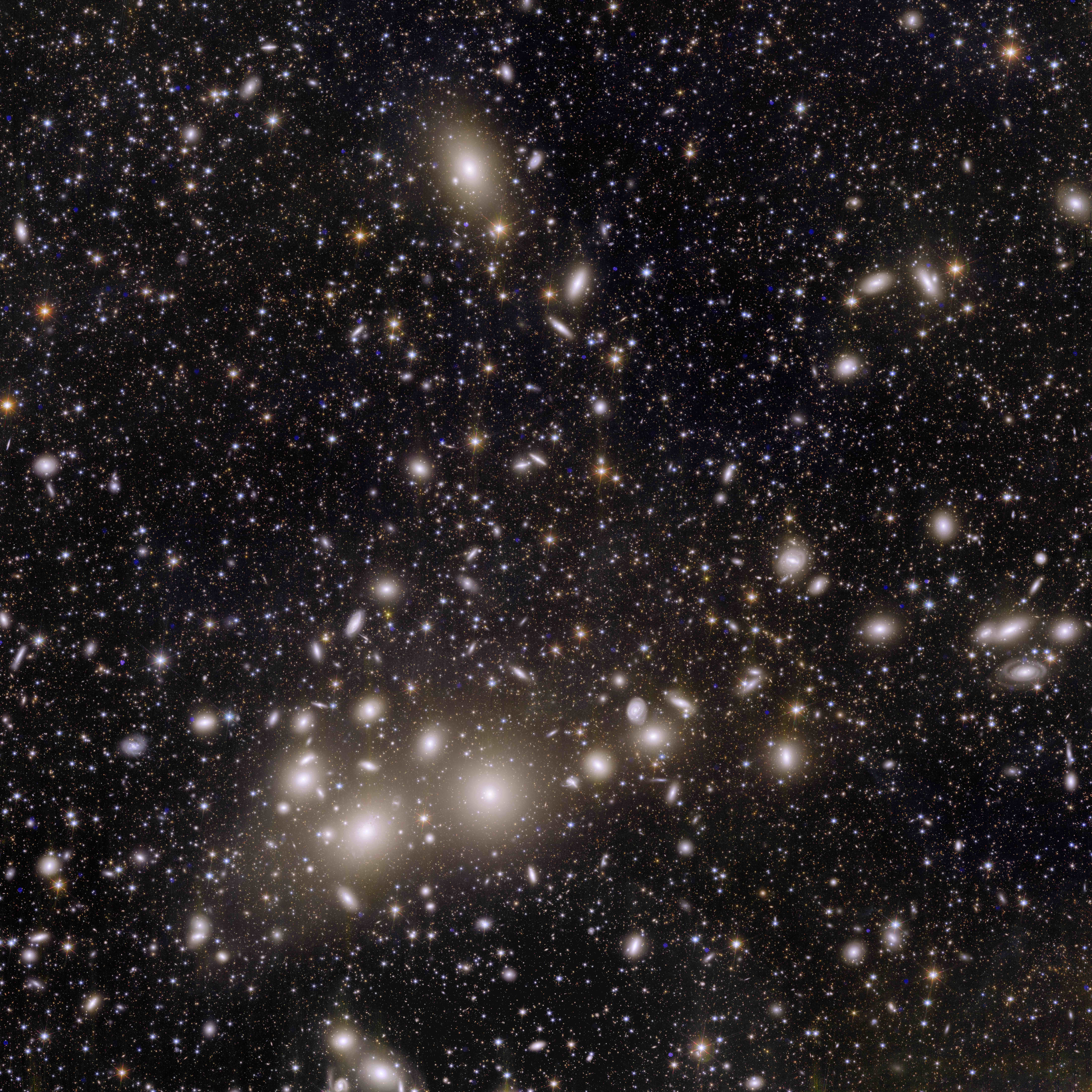
This is because Euclid wasn’t designed to measure the Universe as deeply as possible, with the highest resolution possible, in whatever locations will be deemed “most informative” for a variety of science goals, like Hubble or JWST. Instead, Euclid was designed with a different optimization scheme in mind: to optimize the amount of area-on-the-sky that could be imaged with sufficient:
- detail,
- resolution,
- and wavelength coverage,
to view and characterize the cosmic web, including the formation of cosmic structure over time, from the present-day out to about ~10 billion years ago (to a redshift of z = 2), with each image that it takes.
The main goal of Euclid isn’t to identify and characterize the individual, luminous objects that it sees — the stars and galaxies that appear in its field-of-view — but rather to use the observed information to create the most detailed 3D mapping of the dark universe ever acquired. There are two important aspects to this.
The first is by using its visible and near-infrared instruments to measure the shapes, distances, and clustering properties of galaxies (billions of galaxies, over the spacecraft’s planned lifetime) to infer the 3D mass distribution along every line-of-sight, enabling astronomers to reconstruct the cosmic web, including normal matter but dominated by dark matter, everywhere Euclid observes.

And the second is by using those same instruments to measure not just shapes, distances, and clustering properties of those galaxies, but also to measure their motions — both cosmic (due to the Universe’s expansion) and local/peculiar (due to the gravitational influence of surrounding masses) — and brightnesses to infer the properties of dark energy throughout the Universe.
We have, right now, only a set of very crude, simple models for dark matter and dark energy, that appear to work everywhere we look. We model dark matter as though it’s a massive, slow-moving species of particle that interacts only gravitationally, and is about five times as abundant as normal (atom-based) matter. We model dark energy as though it’s a cosmological constant, behaving as though it has a constant energy density at all times, directions, and locations in the Universe.
But what if these assumptions are only approximately true? What if there’s some sort of non-standard dark matter interaction or some sort of time-or-space evolution to dark energy? These are fascinating possibilities that are only loosely constrained by the observations we have at present. But with the data coming in from ESA’s Euclid, either those constraints are going to get a lot tighter, or we’re going to discover some non-standard behavior for either dark matter or dark energy.

If you were to take the entire night sky and project it onto a sphere, you’d discover that it was absolutely enormous: there are 360 degrees in just a circle, and over the entire night sky, that adds up to more than 40,000 square degrees to cover. If you were to take the entire amount of the night sky imaged by Hubble over the more than 30 years its been in operation, you would find that despite the hundreds of thousands of science observations undertaken by Hubble, that’s translated into less than 1% of the total sky being cumulatively imaged. Similarly, JWST, with its narrow field-of-view, would have to spend millennia imaging the Universe if it were to cover the entire sky.
That’s not the case at all with the ESA’s Euclid mission. All told, over the six planned years of science operations for Euclid (although more are possible), Euclid will spend the majority of its time pointing away from the Milky Way, observing a whopping 14-15,000 square degrees as part of its main survey, covering some 35% or more of the sky. Euclid, from its perch in space, will observe longer wavelengths (red-optical and near-infrared out to about 2.0 microns), and will be complemented by ground-based observations in shorter-wavelength optical ranges (including blue and green filters), meaning that there will somewhere around 10 billion total galaxies imaged in at least 7 different photometric filters apiece. It will provide a window into our cosmic history unlike any other.
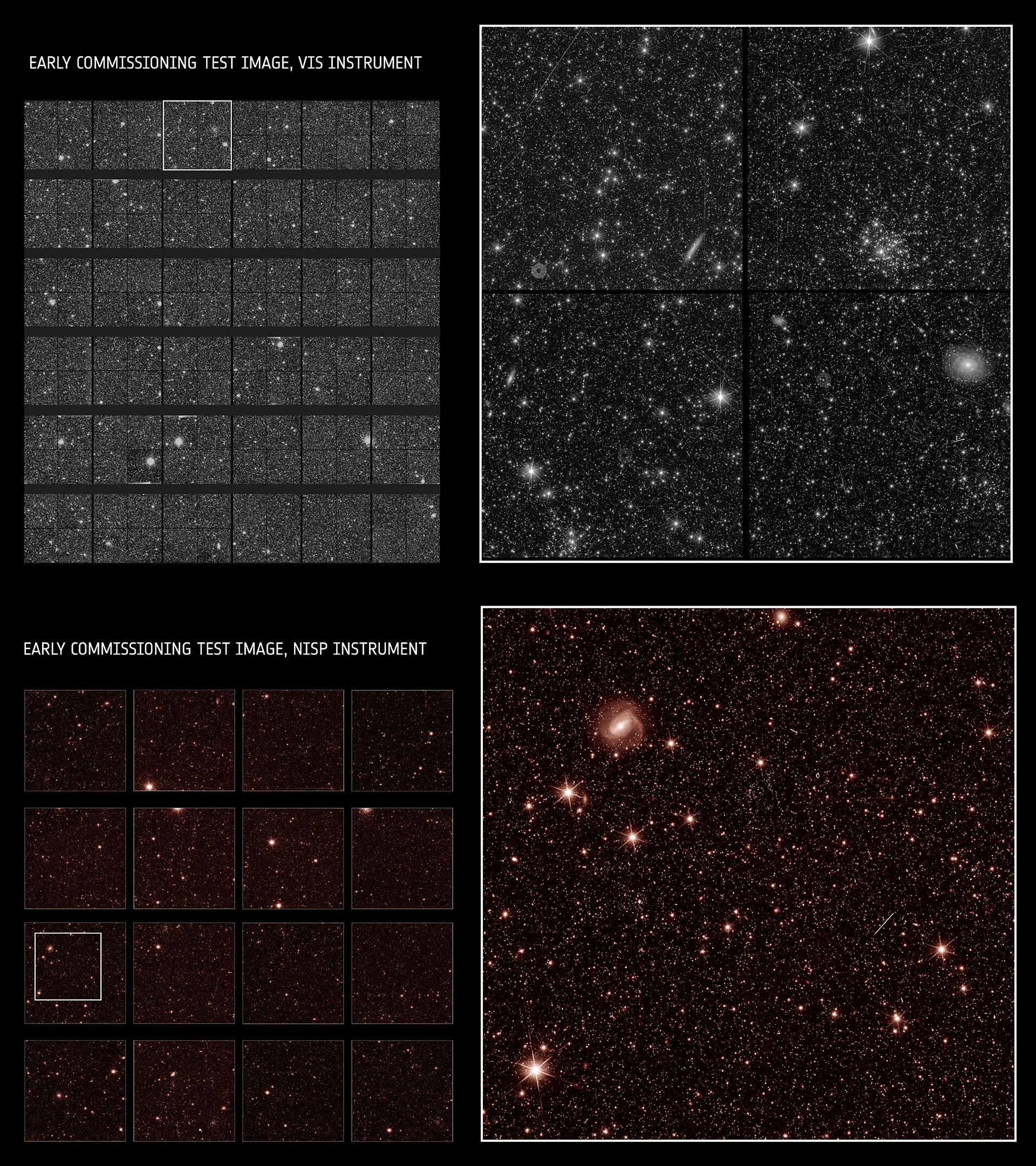
The reason Euclid is so powerful is because of the uniquely powerful combination of properties it has.
- In visible light, its 600+ megapixel VIS instrument achieves resolutions of better than a quarter-of-an-arcsecond, meaning that it can resolve features down to less than a ten-thousandth of a degree, with enough sensitivity to resolve a tiny, kilometer-sized moon like Fenrir at the distance of Saturn.
- In near-infrared light, with only slightly worse resolution, its Near-infrared spectrometer and photometer (NISP) instrument covers three separate wavelength ranges, photometrically, and can also perform slitless spectroscopy on a selection of targets. When combined with the VIS instrument and complementary ground-based data, it will create the largest and most accurate multi-wavelength catalog in the history of extragalactic astronomy.
- And the fact that Euclid uses a novel “step-and-stare” method to image the full 0.57 square degrees of sky that it’s pointing at with each of its instruments, then “steps” to a new, adjacent position, where it stares at the next “tile” in the sky. All told, there will be around 30,000 total “steps” taken by Euclid, allowing the mission’s scientists to construct the largest and highest-resolution mosaic of the sky ever created.
Even though the early data will only provide a small glimpse of the true power of this telescope, it enables us to look forward to the incredible power inherent to the endeavor of exploring the Universe in this fashion.
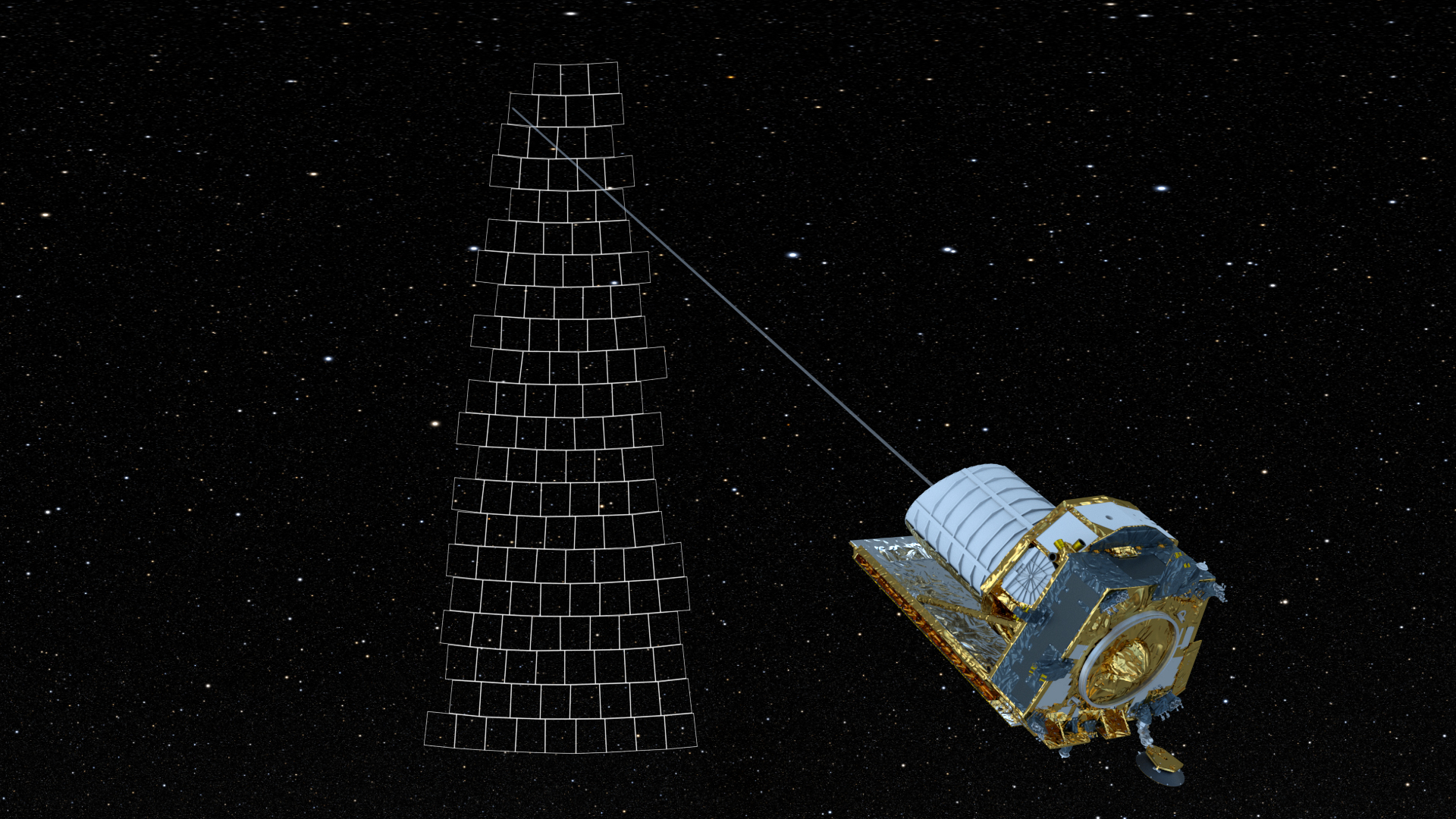
It’s also why even though the first science images themselves from the Euclid mission are visually spectacular, it’s only a tiny hint of the remarkable science we’re going to learn from the full mission. That goal — the unprecedented science — is what we’re all truly after: not just the eye-candy of these spectacular images. As Euclid instrument scientist Knud Jahnke put it:
“With the system launched, you can already take pretty nice pictures of the sky, but the science is often in the details. To really do cosmology, to get better images than would ever have been possible from the ground, it’s not enough.”
The amount of data that’s going to be coming in from Euclid is truly (no pun intended) astronomical in nature, as a total of 9 dedicated data centers will wind up processing more than 170 petabytes of data coming from raw input images over the 6 years of nominal lifetime for Euclid. In addition to the main science goals of building an extragalactic catalog and mapping the clustering and evolutionary properties of dark matter and dark energy, this database will no doubt include a large number of serendipitous discoveries: things we found that we weren’t necessarily looking for, in particular.
The data from Euclid, dependent on what it discovers and where, will provide a new suite of targets for observatories like Hubble, ALMA, and JWST, as well as new targets for future, upcoming missions and observatories as well.

You might not understand this by looking at the first set of science images from Euclid, released on November 7, 2023 by the European Space Agency. It’s tempting to simply look at the majority of the images, like the two shown directly above-and-below, and see just standard, run-of-the mill galaxies. But that’s because these “highlights” are showcasing only the closest large objects to us: the ones that take up the largest areas (or angular sizes) in the sky.
That’s not what makes Euclid special, not by any means. Although it’s true that Euclid will get relatively deep, high-resolution imaging (about half the resolution of Hubble images) for about one-third of all the known objects today, that’s just “extra” scientific value that we gain from the type of work that Euclid is performing: information about the specific features found in nearby galaxies, nebulae, clusters and more.
The main value has nothing to do with these nearby objects: the ones that are prominently displayed in the foregrounds of these images. Instead, it’s all about the fact that these views aren’t merely looking at an object in a particular direction, but rather are looking at all of the light from all of the objects in that specific area of sky: the main foreground object, the more distant galaxies behind it, the even more distant galaxies behind that, and so on, all the way back for approximately 10 billion light-years, everywhere that Euclid looks.

It’s getting that high-resolution, deep imaging in each region of sky that makes Euclid so valuable and so powerful for studying the large-scale Universe, including the dark matter and dark energy within it. When you see a galaxy, nebula, or star cluster, you should think of the following aspects of our Universe, and what we’d miss out on if we limited our views to these individual structures alone.
- If we viewed the Universe as just a collection of stars, we’d miss out on how those stars are grouped and clustered together on larger scales: including in star clusters, globular clusters, and galaxies in all their varied shapes and configurations.
- If we viewed the Universe simply as a collection of nebulae and galaxies, we’d miss out on how those objects are clustered together as well: in groups and clusters of galaxies, as well as clustered along cosmic filaments.
- And if we still only viewed the Universe as a collection of groups/clusters of galaxies with galactic filaments interconnecting them, we’d miss out on the grandest structures of all: the Swiss-cheese-like cosmic web, which not only grows and evolves over time, but which contains unbound pseudostructures — such as superclusters — that will break apart and dissipate with the continued expansion of the Universe.
It’s only because Euclid is measuring its entire viewing area so deeply, thoroughly, and comprehensively that it’s going to be capable of unveiling so much of our Universe’s cosmic history. And soon, it won’t be alone in doing so.

In the relatively near future — hopefully before the decade is out — Euclid will be joined by NASA’s Nancy G. Roman Space Telescope, the next NASA flagship after JWST, as well as the NSF’s ground-based Vera C. Rubin observatory, with the latter scheduled to come online in 2025. Both of these telescopes will also be sensitive, high-resolution, wide-field observatories that gather enormous amounts of data about large portions of the sky, with Roman’s big advantage being that it’s larger and higher-resolution than Euclid, and Rubin’s big advantage being that it can observe the sky repeatedly from the ground, making it ideal for finding transient, or time-evolving, events in the sky, even ultra-faint ones that current programs like Pan-STARRS or ZTF are insensitive to.
But these three observatories, Euclid, Roman, and Rubin, aren’t redundant with one another. Roman will be the highest-resolution and deepest of these observatories, covering the largest wavelength range, but it will also image the smallest amount of sky: encapsulating less than half of Euclid’s area with each view. Rubin will image the largest area of the sky and will do so repeatedly, but with the shallowest views and with limited infrared coverage, owing to its location on the ground, where it must contend with Earth’s atmosphere. And in-between is Euclid: with large, wide-field, deep views covering a total of more than a third of the entire sky, having already begun in 2023: years before the other two.
With Euclid’s science operations now underway, the era of deep, wide-field surveys of the Universe is now upon us, bringing the quest to understand how our Universe has evolved and what it’s made up of one step closer to reality.
